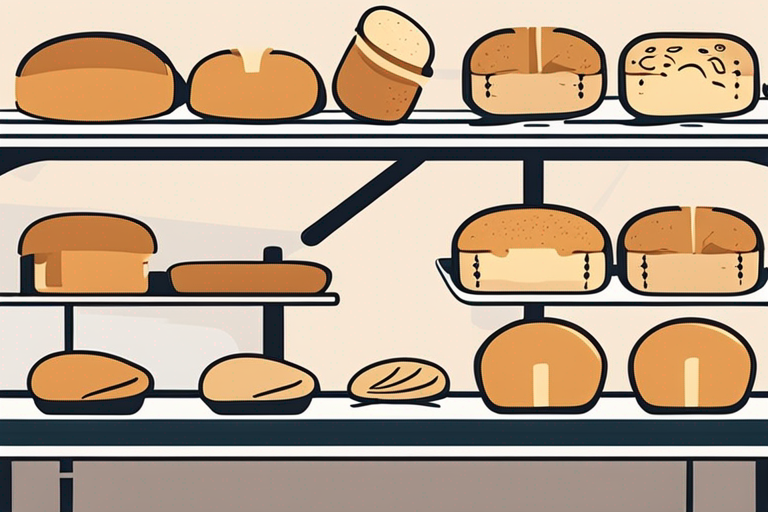
Can You Eat Month-Old Bread? Exploring Food Safety and Storage
Can You Eat Month-Old Bread? Exploring Food Safety and Storage
When it comes to bread, many of us have encountered a loaf that has been sitting in the pantry for longer than we intended. Whether it got lost in the back of the shelf or you simply forgot about it, the question often arises: can you still eat month-old bread? In this blog post, we will delve into the realm of food safety and storage to help you make an informed decision about consuming older bread.
Still unsure if This Food is safe?
Every situation is different. Get a personalized food safety verdict for your this food based on the date, storage, and condition — in seconds.
👉 Check Food Safety NowUnderstanding Bread Shelf Life
Bread is a staple food that can be found in households around the world. From baguettes to sandwich loaves, bread comes in various forms and flavors. However, like all perishable items, bread has a limited shelf life. Here are some key points to consider when evaluating the freshness of bread:
Factors Affecting Bread Spoilage
- Ingredients: The type of flour, preservatives, and additives used in bread can impact its shelf life.
- Storage: Proper storage is crucial to maintaining the freshness of bread. Storing bread in a cool, dry place can help prevent mold growth.
- Exposure: Bread that is left out in the open or exposed to moisture is more likely to spoil quickly.
Can You Eat Month-Old Bread?
The answer to whether you can eat month-old bread depends on several factors. Let's break it down:
Signs of Spoiled Bread
Before consuming older bread, it's essential to inspect it for signs of spoilage. Here are some indicators that your bread may have gone bad:
- Mold: Visible mold growth on the surface of the bread is a clear sign that it is no longer safe to eat.
- Off Odor: If your bread smells sour, musty, or off-putting, it is best to discard it.
- Texture: Stale, soggy, or unusually hard bread may indicate spoilage.
Safety Considerations
While some types of bread, such as sourdough, can last longer due to their natural acidity, it's crucial to exercise caution when consuming older bread. Here are some safety considerations to keep in mind:
- Foodborne Illness: Eating spoiled bread can lead to food poisoning and stomach discomfort.
- Mycotoxins: Mold growth on bread can produce harmful mycotoxins that are hazardous to health.
- Allergies: Individuals with wheat or gluten allergies should be especially cautious when consuming older bread.
Tips for Extending Bread Freshness
To make the most of your bread and prevent unnecessary waste, consider the following tips for extending its freshness:
- Proper Storage: Store bread in airtight containers or resealable bags to keep it fresh longer.
- Freezing: If you don't plan on consuming bread immediately, consider freezing it in individual slices for future use.
- Reviving Stale Bread: To revive stale bread, sprinkle it with water and reheat it in the oven for a few minutes.
Conclusion
In conclusion, while it is generally safe to consume bread that is a few days old, month-old bread may pose risks of spoilage and foodborne illness. When in doubt, it's best to err on the side of caution and discard bread that shows signs of spoilage. By understanding the factors that influence bread freshness and implementing proper storage practices, you can enjoy your bread while ensuring food safety. Remember, when it comes to food, safety always comes first.
Still unsure if This Food is safe?
Every situation is different. Get a personalized food safety verdict for your this food based on the date, storage, and condition — in seconds.
👉 Check Food Safety NowNext time you find yourself wondering about the safety of that forgotten loaf of bread, refer back to this guide to make an informed decision. Stay safe, stay informed, and enjoy your bread responsibly!

Still unsure if This Food is safe?
Every situation is different. Get a personalized food safety verdict for your this food based on the date, storage, and condition — in seconds.
👉 Check Food Safety NowAuthoritative Food Safety References
These agencies and university labs inform every tip and health precaution we publish.
USDA FoodKeeper – Cold Storage Guidelines
Official refrigerator, freezer, and pantry timelines maintained by the U.S. Department of Agriculture.
Visit USDA FoodKeeperFDA Produce Safety Rule & Grower Guidance
Field-to-fridge handling practices that prevent contamination of fruits, vegetables, and leafy greens.
Visit FDA Produce SafetyCDC Foodborne Illness Prevention Hub
Surveillance-backed guidance on pathogens, symptoms, and steps to reduce foodborne illness risk.
Visit CDC Food SafetyUC Davis Postharvest Technology Center
University research detailing optimal storage atmospheres for produce after harvest.
Visit UC Davis PostharvestPenn State Extension – Home Food Preservation & Safety
Peer-reviewed extension bulletins on safe canning, chilling, and reheating practices.
Visit Penn State Extension